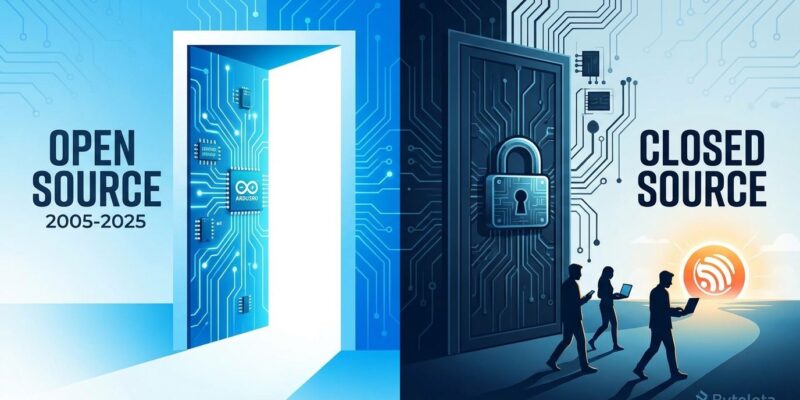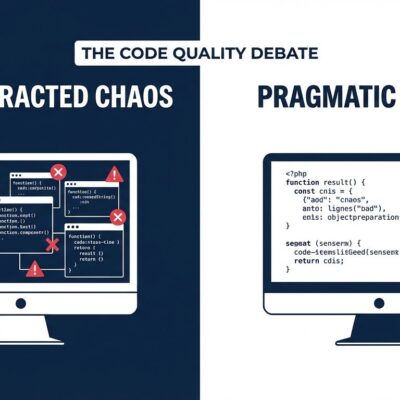
Arduino Closes The Door It Opened
Arduino published updated terms and conditions this week that fundamentally change the platform from an open commons to a restricted ecosystem. After 20 years as the poster child for open-source hardware — 30 million boards sold worldwide, used in 80% of university engineering programs, the foundation of the entire maker movement — Arduino is walking away from the community that built it. Developers are responding with anger, disappointment, and migration planning. The exodus to ESP32 and Raspberry Pi Pico has already begun.
What Actually Changed
Arduino’s previous licensing model was community-friendly: hardware designs under Creative Commons BY-SA, software under GPL/LGPL, commercial use allowed with attribution, clones tolerated and even encouraged. The ecosystem thrived because anyone could build, modify, sell, and share Arduino-compatible projects without legal fear.
The new terms flip this completely. Based on detailed community investigation and Hacker News discussion, the updated terms introduce restrictive commercial licensing, limits on derivative works, aggressive trademark enforcement, fork restrictions, and potential licensing fees for Arduino-compatible boards.
The specifics remain deliberately vague, creating legal uncertainty that paralyzes the ecosystem. Universities selling Arduino-based robot kits to fund engineering programs don’t know if they need licensing fees. Startups with commercial products built on Arduino fear retroactive enforcement. Makers sharing tutorial projects wonder if readers can still build and sell derivatives.
Why Arduino Made This Choice
To be clear: open-source hardware monetization is genuinely difficult. Chinese manufacturers sell Arduino clones for $3 while official boards cost $24. The Arduino IDE and extensive software libraries cost money to maintain, yet the community contributes code but rarely funding. Speculation points to Qualcomm acquisition pressure forcing desperate monetization attempts.
This context makes Arduino’s decision understandable. It also makes it suicide.
Arduino Destroyed Its Only Competitive Advantage
Arduino’s value was never the technology. An 8-bit microcontroller running at 16MHz with 2KB of RAM is objectively outdated in 2025. The ESP32 runs at 240MHz with 520KB RAM, includes WiFi and Bluetooth, and costs $3 instead of $24. The Raspberry Pi Pico offers dual-core ARM Cortex-M0+ at 133MHz for $4. Technically, Arduino lost the hardware war years ago.
Arduino persisted because of the ecosystem and community. The massive library collection. The beginner-friendly tutorials. The educational trust. The maker ethos. The philosophical commitment to open hardware. Developers stayed loyal to Arduino despite inferior specs because Arduino represented principles over performance.
By closing the platform, Arduino destroyed the only thing that differentiated it from superior alternatives. Without the open ecosystem, Arduino is just an overpriced, underpowered microcontroller competing against platforms that are faster, cheaper, and actually open. The community was the product. Arduino killed the product.
The Migration Path: ESP32 Wins By Default
Developers aren’t waiting around to see what happens next. The migration conversation on Hacker News focuses overwhelmingly on ESP32 as the replacement. The technical advantages are overwhelming: 240MHz dual-core processor, built-in WiFi and Bluetooth, 520KB RAM, Arduino IDE compatibility, massive library ecosystem, and full open-source hardware and software. Price: $2-4 for development boards.
Migration difficulty is minimal. Approximately 80% of Arduino libraries have ESP32 ports. The Arduino IDE supports ESP32 natively. Pin-compatible shields exist. Most Arduino projects convert in one to two days of work. The main gotcha: ESP32 uses 3.3V logic instead of Arduino’s 5V, requiring level shifters for some older sensors.
The Raspberry Pi Pico (RP2040) is the alternative for education-focused users. At $4 with strong Raspberry Pi Foundation backing, excellent documentation, and MicroPython support, it targets Arduino’s educational stronghold directly. Migration is slightly harder than ESP32 (different ARM architecture) but manageable in two to four days.
The community response shows migration isn’t theoretical — it’s happening now. Tutorial creators are porting content to ESP32. Library maintainers are prioritizing ESP32 support. Educational institutions are evaluating platform switches. The network effects that built Arduino are reversing rapidly.
History Repeats: MySQL, MongoDB, Now Arduino
This story has played out before. When Oracle acquired Sun Microsystems in 2010 and took control of MySQL, licensing concerns drove the community to fork MariaDB. MariaDB now thrives while MySQL declines in relevance. MongoDB’s 2018 switch to the restrictive Server Side Public License prompted AWS to create DocumentDB, isolating MongoDB from major cloud providers.
The pattern is consistent: open-source projects that shift to proprietary licensing face community revolt, forks that often surpass the original, and long-term irrelevance despite short-term revenue attempts. Trust, once broken, never fully recovers. You cannot close what was open without destroying the community that made it valuable.
Arduino is following this exact pattern. The technical alternatives already existed and were superior. Arduino’s openness was the only barrier preventing mass migration. That barrier just disappeared.
The End of an Era
Arduino defined the open-source hardware movement. It democratized electronics, taught millions of students, enabled thousands of commercial products, and proved that hardware could be as open as software. For 20 years, Arduino kept that promise. This week, Arduino broke it.
Open-source hardware sustainability is a real problem. Arduino needed revenue to survive. But monetizing by restricting what was open guarantees neither sustainability nor survival. Arduino should have monetized services — cloud integration, premium IDE features, professional support — not restricted the hardware and ecosystem.
The makers will remember this betrayal. Arduino’s name will become synonymous with “the platform that abandoned its principles for money and died anyway.” The migration to ESP32 and Raspberry Pi Pico is already accelerating. Within 18 months, Arduino will be a legacy curiosity while ESP32 dominates the maker and IoT spaces Arduino once owned.
Choose platforms that respect openness. Choose platforms with strong community commitments. Choose platforms where the technology is competitive, not just the philosophy. Arduino was all three. Now it’s none.
Rest in peace, Arduino, 2005-2025. We’ll remember what you were, not what you became.



